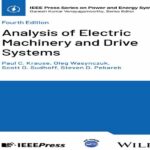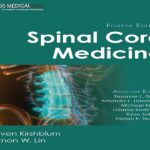- عنوان کتاب: Analysis of Electric Machinery and Drive Systems
- نویسنده: Paul C Krause
- حوزه: ماشینهای الکتریکی
- سال انتشار: 2025
- تعداد صفحه: 483
- زبان اصلی: انگلیسی
- نوع فایل: pdf
- حجم فایل: 12.4 مگابایت
این کتاب برای دانشجویان تحصیلات تکمیلی و مهندسان علاقهمند به تحلیل ماشینها و درایوها نوشته شده است. فصل ۱ برخی از مفاهیم اساسی رایج در کتابهای این حوزه را پوشش میدهد. این ویرایش چهارم از چندین جهت با ویرایشهای قبلی متفاوت است. به عنوان مثال، تبدیل برای هر دو متغیر q و d از عبارت نیروی محرکه مغناطیسی دوار یا mmf بدست میآید. این یک رویکرد بسیار ساده است که منشأ تحلیلی تبدیل را ارائه میدهد. همچنین، تحلیل هر ماشین بر عملکرد موتور متمرکز است تا زمینه را برای درایوهای الکتریکی فراهم کند، اگرچه در مورد ماشین سنکرون، عملکرد ژنراتور در نظر گرفته میشود. همچنین، از آنجایی که برای اهداف تحلیل، استاتورهای ماشینهای AC مورد بررسی در این متن یکسان هستند، استاتورها یک بار در فصل ۲ در نظر گرفته میشوند و تحلیل برای هر ماشین تکرار نمیشود. با این حال، روتورها متفاوت هستند و برای هر ماشین جداگانه در نظر گرفته میشوند. این کار به طور قابل توجهی کار را کاهش میدهد. ماشین القایی در فصل ۳ در نظر گرفته شده است. اکثر موتورهای القایی دارای روتورهای قفس سنجابی هستند. با این حال، اگر استاتور دارای سیمپیچهای توزیعشده سینوسی باشد، روتور نیز میتواند به عنوان دارای سیمپیچهای توزیعشده سینوسی در نظر گرفته شود، حتی اگر روتور ممکن است از میلههای توپر تشکیل شده باشد. تبدیل متغیرهای روتور به محورهای q و d تنها در این تفاوت دارد که سیمپیچهای روتور نسبت به استاتور میچرخند. ماشین AC آهنربای دائم و ژنراتور سنکرون به ترتیب در فصلهای ۴ و ۵ بررسی میشوند. در فصل ۴، ماشین DC بدون جاروبک را با Ld = Lq بررسی میکنیم. سه مقدار مختلف زاویه بین Ṽ as و Ẽ a یا 𝜙v در نظر گرفته شده است. این مقادیر عبارتند از: 𝜙v = 0 که رایجترین حالت عملیاتی است، 𝜙v = 𝜙v,MT/V یا حداکثر گشتاور بر ولت، و 𝜙v = 𝜙v,MT/A یا حداکثر گشتاور بر آمپر. در این حالت، روتور آهنربای دائم به صورت سینوسی مغناطیسی در نظر گرفته میشود. بخش اول فصل ۵ به عملکرد موتور یک ماشین سنکرون اختصاص دارد. بخش دوم به عملکرد ژنراتور با جریان مثبت فرض شده از ماشین اختصاص دارد. این حالت اخیر عملکرد توسط پارک در مقاله کلاسیک خود که در سال ۱۹۲۹ نوشته شده است، مورد بررسی قرار گرفته است. تجزیه و تحلیل اولیه ماشینهای AC که در این متن پوشش داده شده است، با فصل ۵ به پایان میرسد. مهندسان سیستمهای قدرت میتوانند با فصلهای ۶، ۷ و ۸ ادامه دهند. مهندس درایوها این فصلها را پوشش نمیدهند، بلکه به فصلهای ۱۰ تا ۱۴ میپردازند و احتمالاً برخی از مطالب فصل ۵ را حذف میکنند. در فصل ۶، مفهوم نادیده گرفتن گذراهای استاتور مورد بررسی قرار میگیرد. این فصل برای مهندس سیستمهای قدرت بیشترین علاقه را خواهد داشت زیرا به اساس برنامههای پایداری گذرا که در مطالعات پایداری سیستمهای قدرت استفاده میشود، میپردازد. هم مهندسان سیستمهای قدرت و هم مهندسان درایو میتوانند فصل ۹ را جالب بیابند. مهندسان درایوها مایل به مطالعه فصل ۱۰ هستند، زیرا رایجترین استراتژیهای مدولاسیون مورد استفاده را شرح میدهد. فصل ۱۱ به درایوهای DC میپردازد. این فصل مختصر است اما به مهندسی درایو الکتریکی مرتبط است. در فصل ۱۲، کنترل گشتاور ماشینهای AC با آهنربای دائم و رلوکتانسی سنکرون بررسی شده است. تحلیل ماشین آهنربای دائم مشابه مطالب فصل ۴ است. تفاوت در این است که Ld ≠Lq و گشتاور رلوکتانسی وجود دارد. پارامترهای ماشین مورد بررسی، نمایانگر موتورهای محرک الکتریکی مورد استفاده در خودروهای هیبریدی و الکتریکی هستند. ماشین رلوکتانسی سنکرون با حذف آهنرباهای دائمی در نظر گرفته شده است، که در آن فقط گشتاور رلوکتانسی وجود دارد. ماشینهای رلوکتانسی سنکرون نیز به عنوان کاندیداهای مناسب به عنوان موتورهای محرک الکتریکی در خودروهای هیبریدی و الکتریکی در نظر گرفته میشوند. نشان داده شده است که با کنترل جریان مبتنی بر الکترونیک قدرت، گذراهای الکتریکی آنقدر سریع هستند که ممکن است هنگام بررسی دینامیک مکانیکی نادیده گرفته شوند. کنترل موتور القایی در فصل ۱۳، شامل روشهای کنترل ولت-هرتز، لغزش ثابت و میدان-محور، بررسی شده است. هر یک با جزئیات قابل توجهی بررسی شدهاند. در نهایت، کنترل ماشینهای AC با آهنربای دائم در فصل ۱۴ بررسی شده است. اگرچه این یک متن درسی برای مقاطع تحصیلات تکمیلی است، اما شش یا هفت فصل اول میتواند در سطح ارشد و فصلهای باقیمانده به عنوان متن درسی برای مقاطع تحصیلات تکمیلی مورد استفاده قرار گیرد.
This book is written for graduate students and engineers interested in machines and drives analysis. Chapter 1 covers some basic concepts that are common to books in this area. This fourth edition differs from previous editions in several ways. For example, the transformation for both the q and d variables is obtained from the expression of the rotating magnetomotive force or mmf. This is a very straightforward approach that provides an analytic origin of the transformation. Also, the analysis of each machine is focused on motor action to set the stage for electric drives, although generator action is considered in the case of the synchronous machine. Also, since for analysis purposes the stators of the AC machines considered in this text are the same, the stators are considered once in Chapter 2 rather than repeating the analysis for each machine. However, the rotors are different and are treated separately for each machine. This reduces the work considerably. The induction machine is considered in Chapter 3.Most induction motors have squirrel-cage rotors. However, if the stator has sinusoidally distributed windings, the rotor may also be considered as having sinusoidally distributed windings even though the rotor may consist of solid bars. The transformation of the rotor variables to the q and d axes differs only in that the rotor windings are rotating relative to the stator. The permanent-magnet AC machine and the synchronous generator are considered in Chapters 4 and 5, respectively. In Chapter 4, we treat the brushless DC machine with Ld = Lq. Three different values of angle between Ṽ as and Ẽ a, or 𝜙v, are considered. These are: 𝜙v = 0, which is the most common operating mode, 𝜙v = 𝜙v,MT/V or maximum torque per volt, and 𝜙v = 𝜙v,MT/A or maximum torque per ampere. In this case, the permanent-magnet rotor is considered to be magnetized sinusoidally. The first part of Chapter 5 is devoted tomotor action of a synchronous machine. The second part is devoted to generator action with positive current assumed out of the machine. This latter mode of operation was treated by Park in his classic paper written in 1929. The basic analysis of AC machines covered in this text ends with Chapter 5. Power systems engineers could continue with Chapters 6, 7, and 8. The drives engineer would not cover these chapters, but would skip to Chapters 10 through 14, and would likely omit some of the material in Chapter 5. In Chapter 6, the concept of neglecting stator transients is treated. This chapter would be of most interest to the power systems engineer since it deals with the basis of transient stability programs used in stability studies for power systems. Both power systems and drives engineers could find Chapter 9 interesting. Drives engineerswouldwant to study Chapter 10, as it describes themost commonly used modulation strategies. Chapter 11 deals with DC drives. This chapter is brief but relevant to electric drive engineering. In Chapter 12, the torque control of permanent-magnet AC and synchronous reluctance machines are considered. The analysis of the permanent-magnet machine is similar to the material in Chapter 4. The difference is that Ld ≠Lq and a reluctance torque exists. The parameters of the machine considered are representative of electric drive motors used in hybrid and electric vehicles. The synchronous reluctance machine is considered with the permanent magnets removed, whereby only a reluctance torque exists. Synchronous reluctance machines are also considered as viable candidates as electric drive motors in hybrid and electric vehicles. It is shown that with power-electronic-based current control, the electric transients are so fast that they may be neglected when considering the mechanical dynamics. Induction motor control is considered in Chapter 13, including the volt-perhertz, constant-slip, and field-oriented control methods. Each is considered in substantial detail. Finally, the control of permanent-magnet AC machines is considered in Chapter 14. Although this is a graduate text, the first six or seven chapters could be used at the senior-level with the remaining chapters used as a graduate text.
این کتاب را میتوانید از لینک زیر بصورت رایگان دانلود کنید:





































نظرات کاربران